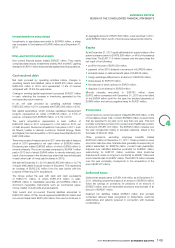APC 2011 Annual Report Download - page 141
Download and view the complete annual report
Please find page 141 of the 2011 APC annual report below. You can navigate through the pages in the report by either clicking on the pages listed below, or by using the keyword search tool below to find specific information within the annual report.
1392011 REGISTRATION DOCUMENT SCHNEIDER ELECTRIC
CORPORATE GOVERNANCE
3
INTERNAL CONTROL AND RISK MANAGEMENT
The list of Key Internal Controls continues to grow. In 2011, the
Global Functional Department defi ned Key Internal Controls covering
the Bid Creation and Administration process; these controls were
self-evaluated by the major Research and Development units.
A software package for the management of Internal Audit and
Internal Control self-assessment questionnaires and follow-up
action plans will be introduced to replace the “in-house” application
used to date.
A regional internal control organisation was introduced in 2011 that
consists of 28regional in-house controllers in three regions, who:
•perform the duties defi ned under Section2.3 for the units in their
regional scope, covering all Operational Departments;
•establish standardised procedures (e.g. for internal control
assignments such as control cycles, documentation,
scope defi nition, work programs etc.), in line with Internal
Audit≈procedures.
Internal Audit Department
In addition to fi ne-tuning the general risk matrix and performing
audits to ensure these risks are managed properly, the Internal
AuditDepartment:
•monitors and reviews the way that Key Internal Controls
areapplied;
•critically reviews the audited unit’s internal control self-assessment
and related action plans.
The Department’s audit assignments go beyond the Key Internal
Controls, and include an in-depth review of processes and their
effectiveness, focusing on compliance and/or performance,
depending on the size of the audited unit and the identifi ed risks
and challenges.
The internal auditors also review newly acquired units to assess
their level of integration and ensure that Group rules and guidelines
are properly applied.
A summary overview of the department’s audits makes it possible
to identify any emerging or recurring risks that require new
risk management tools and methodologies or adjustments to
existingresources.
In 2011, Senior Management ordered unscheduled audits on
emerging risks that led to the revision of certain internal procedures.
In 2011, the internal auditors performed 22audits, including:
•full audits of medium-sized units;
•audits of a number of risks or operating processes;
•post-acquisition audits for newly acquired companies;
•analyses of control self-assessments by the units;
•follow-up audits to ensure recommendations are applied;
•assistance assignments .
Committee on Ethics and Responsibility
The Committee on Ethics and Responsibility steers action in relation
to the Principles of Responsibility, updates them and validates
changes. It also answers employee questions that are not addressed
in the companion guide to the Principles of Responsibility, or that
employees’ own managers are unable to answer.
(see “Sustainable development framework”, Chapter2 Section2.)
Fraud Committee
In 2010, the Fraud Committee formalised the policy against fraud
and the process of reporting and treating fraud and suspected fraud,
including changes in procedures or practices to avoid recurrence.
Declared incidents are monitored by the Fraud Committee,
which meets on a monthly basis. The Fraud Committee decide
on investigations that are managed either by the local units or
centrally by the Fraud Committee depending on the nature and
the seriousness of the incident. A report is written and updated
monthly for this purpose. The Fraud Committee presents an annual
summary report to the Audit Committee.
2011: stronger internal control system
In 2011, further efforts were made to improve the identifi cation and
control of general risks, to step up periodic reviews of results and
performance, and to enhance auditing practices. The year was
marked, for the internal control system, by the items set out above,
in particular:
•the Fraud Committee’s procedures were defi ned and implemented
for investigation and analysis of the identifi ed incidents of fraud;
•regional internal control units were set up in an internal control
system covering three levels: management, regional internal
control and internal audit;
•a dedicated software package for the management of
self- assessment questionnaires and follow-up action plans will
be ushered in to replace the “in-house” application used to date;
•internal control self-assessment questionnaires were sent out
to cover 90% of the Group’s consolidated revenue (training
managers in internal control practices, defi ning and implementing
remedial action plans if needed) including units from the
acquisition of Areva Distribution;
•administrative measures were pursued regarding segregation of
duties in the informationsystems.
10.6 Internal control procedures governing the production and processing
ofconsolidated and individual company accounting and financial
information
In addition to:
•its regulatory tasks;
•its responsibility for overseeing the close of accounts across the
Group;
•its audits of the Group’s results with respect to set targets (see
“Internal Control Organisation and Management: Finance and
Control – Legal Affairs”).
























